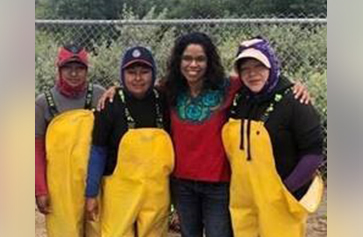Center for Community Engagement debuts new name, new website, and campus database for community partnerships

Jessa Calderon (Tongva and Chumash) Photo credit: Kote Melendez
The UCLA Center for Community Learning has a new name.
As of November 10, the Center will be known as the UCLA Center for Community Engagement, reflecting the Center’s continued goal to connect UCLA students with community partners to provide both a learning experience for students and a benefit to the communities, locally and globally.
The Center for Community Engagement promotes and supports community-engaged research, teaching and learning in partnership with communities and organizations throughout Los Angeles, regionally, nationally and globally. The Center facilitates faculty and student work that integrates sustained, reciprocal engagement with the public and helps transform UCLA’s mission to support the co–creation, co–dissemination, co–preservation and co–application of knowledge.

A recipient of the Chancellor’s Award for Community-Engaged Scholars, Gaye Theresa Johnson, meeting with cilantro workers as part of her ongoing community-engaged research on food justice. (Photo Credit: UCLA)
The Center is tasked by the Undergraduate Council to administer the university’s “community-engaged course” framework. It does this by supporting faculty across the university who are interested in developing such community-engaged courses, and ultimately approving the “XP” course suffix that identifies these courses.
The Center also coordinates the Chancellor’s Awards for Community-Engaged Scholars, a program that recognizes outstanding scholarship and supports faculty to develop new courses to integrate undergraduates into their ongoing community-engaged research. The Center’s student-facing programming includes 195CE internship courses, the community engagement and social change minor, the Astin Community Scholars research program, the Changemaker Scholars program, and AmeriCorps volunteer programs.
The name change was inspired by Executive Vice Chancellor and Provost Emily A. Carter at a meeting last year with the vice chancellors and Chancellor Gene Block. Center for Community Learning director Shalom Staub and Vice Provost for International Studies and Global Engagement Cindy Fan gave a presentation about UCLA’s new strategic priorities for local and global engagement.
Staub said Carter took note of the reciprocal nature of the Center’s community-engaged programs. She noticed that the Center’s name only notes the value for student learning but ignores the ways that the work is intentionally designed to create value for community partners. The name “Center for Community Learning” didn’t convey both sides, she said.
“This name change highlights the importance of meaningful engagement as the cornerstone of effective community-based research and education,” Carter said. “It is a stronger reflection of the center’s philosophy and work, and it emphasizes the idea that our relationships with communities and organizations throughout Los Angeles are true reciprocal partnerships.”
Dean of Undergraduate Education Adriana Galvan said the new name represents the meaningful learning and authentic community-engaged experiences students have with community partners as well as UCLA’s commitment to creativity, community engagement, research, and learning across disciplines.
“Community engagement is a crucial ingredient to the undergraduate experience because it brings to life the learning that happens in a classroom and ensures that our students have the opportunity to reflect on the ways in which the university connects to the broader community,” she said.
In addition to the name change, the Center launched a new website and will soon debut a new online database of community engaged work at UCLA. Through an online platform called Collaboratory, community-centered research or teaching at UCLA will be logged, categorized and searchable, allowing users to see how community-engaged work at UCLA is connected across campus and across community partner organizations.
“Rather than talk abstractly about community-engaged work, or rather than describe just the work of a specific course, this is going to allow us to aggregate and to visualize community-engaged work at UCLA,” Staub said. “The scale and scope of this work is going to start to become much more real.”
This article was written by Robin Migdol.




